lock FORD POLICE INTERCEPTOR SEDAN 2015 1.G Owners Manual
[x] Cancel search | Manufacturer: FORD, Model Year: 2015, Model line: POLICE INTERCEPTOR SEDAN, Model: FORD POLICE INTERCEPTOR SEDAN 2015 1.GPages: 401, PDF Size: 3.86 MB
Page 2 of 401
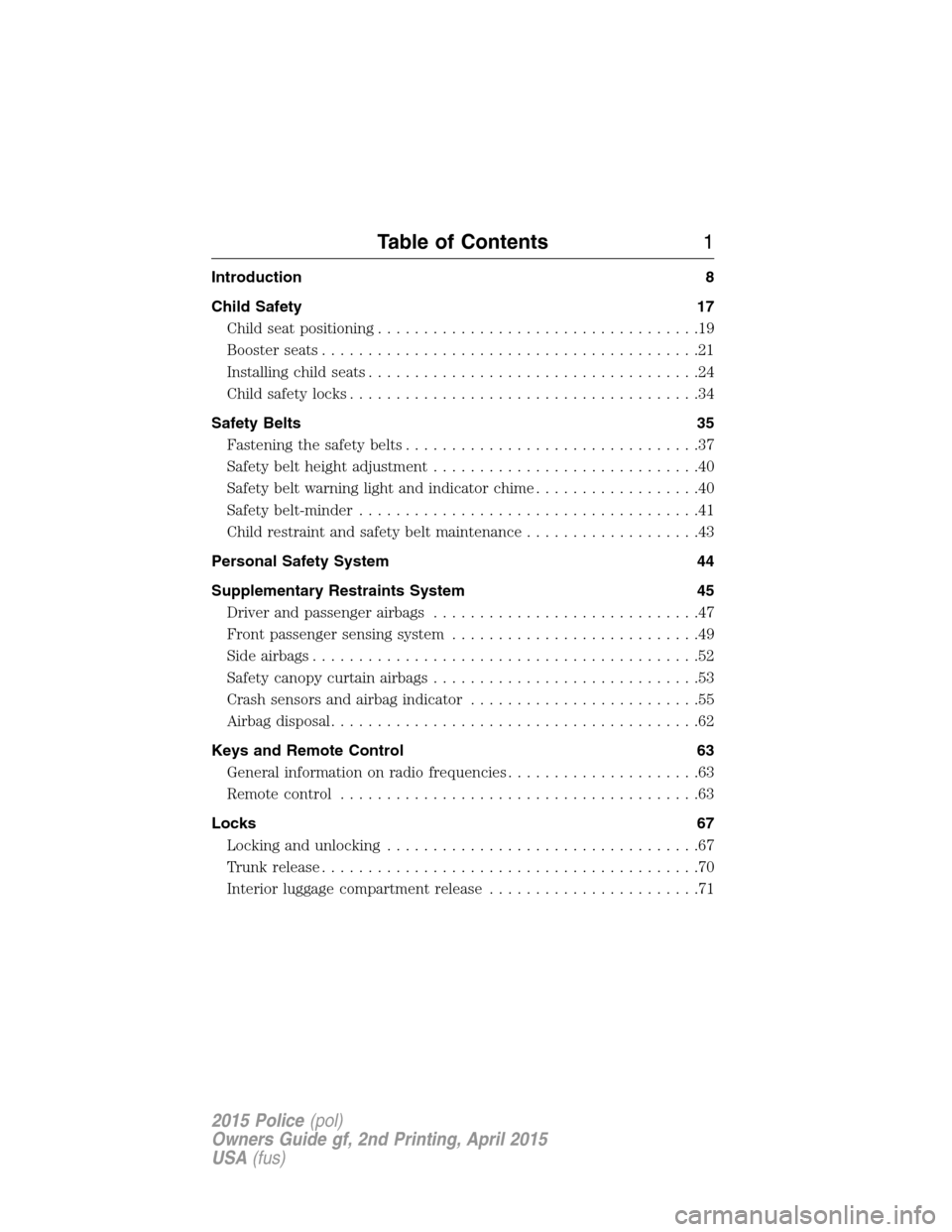
Introduction 8
Child Safety 17
Child seat positioning...................................19
Booster seats.........................................21
Installing child seats....................................24
Child safety locks......................................34
Safety Belts 35
Fastening the safety belts................................37
Safety belt height adjustment.............................40
Safetybeltwarninglightandindicatorchime..................40
Safety belt-minder.....................................41
Child restraint and safety belt maintenance...................43
Personal Safety System 44
Supplementary Restraints System 45
Driver and passenger airbags.............................47
Front passenger sensing system...........................49
Side airbags..........................................52
Safety canopy curtain airbags.............................53
Crash sensors and airbag indicator.........................55
Airbag disposal........................................62
Keys and Remote Control 63
General information on radio frequencies.....................63
Remote control.......................................63
Locks 67
Locking and unlocking..................................67
Trunk release.........................................70
Interior luggage compartment release.......................71
Table of Contents1
2015 Police(pol)
Owners Guide gf, 2nd Printing, April 2015
USA(fus)
Page 4 of 401
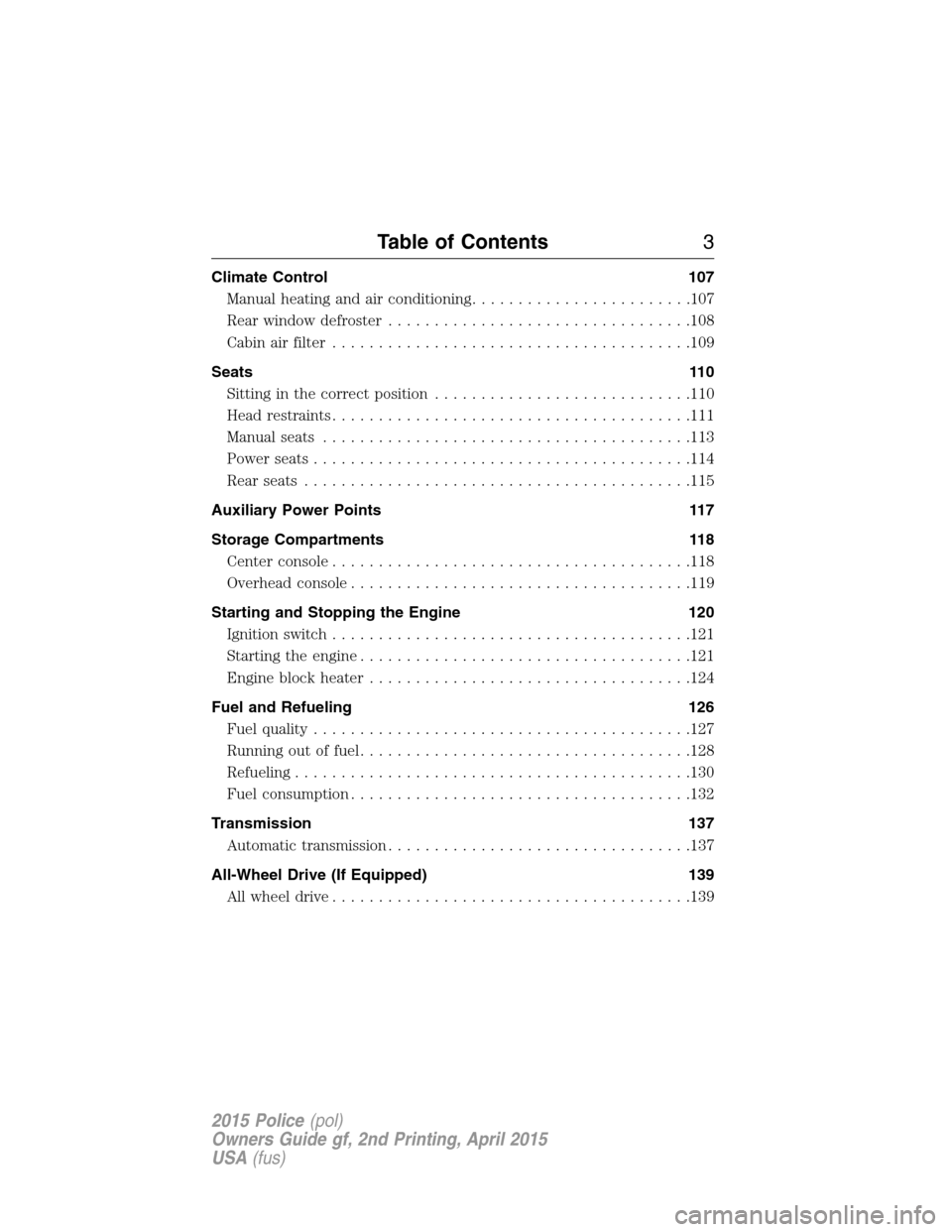
Climate Control 107
Manual heating and air conditioning........................107
Rear window defroster.................................108
Cabin air filter.......................................109
Seats 110
Sitting in the correct position............................110
Head restraints.......................................111
Manual seats........................................113
Power seats.........................................114
Rear seats..........................................115
Auxiliary Power Points 117
Storage Compartments 118
Center console.......................................118
Overhead console.....................................119
Starting and Stopping the Engine 120
Ignition switch.......................................121
Starting the engine....................................121
Engine block heater...................................124
Fuel and Refueling 126
Fuel quality.........................................127
Running out of fuel....................................128
Refueling...........................................130
Fuel consumption.....................................132
Transmission 137
Automatic transmission.................................137
All-Wheel Drive (If Equipped) 139
All wheel drive.......................................139
Table of Contents3
2015 Police(pol)
Owners Guide gf, 2nd Printing, April 2015
USA(fus)
Page 5 of 401
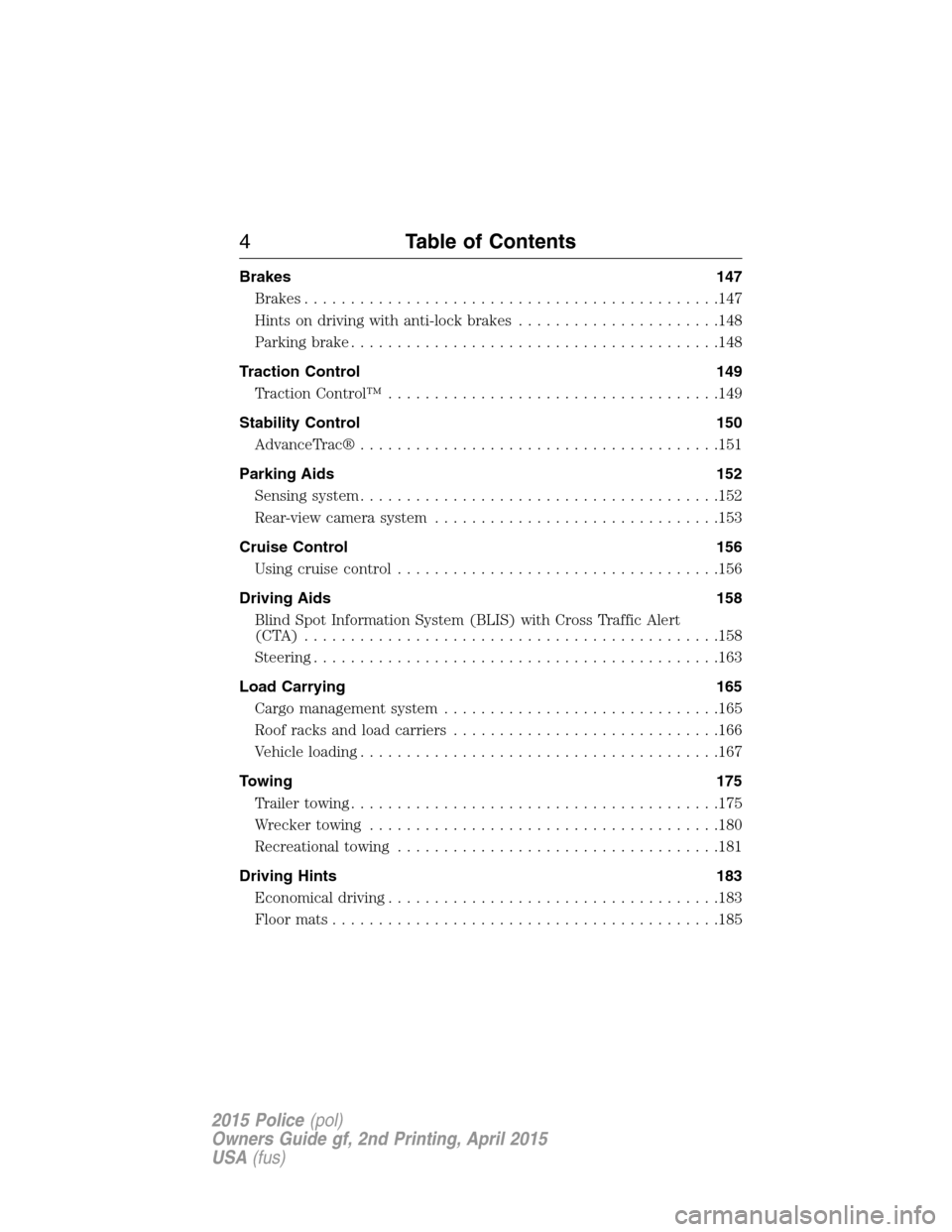
Brakes 147
Brakes.............................................147
Hints on driving with anti-lock brakes......................148
Parking brake........................................148
Traction Control 149
TractionControl™ ....................................149
Stability Control 150
AdvanceTrac®.......................................151
Parking Aids 152
Sensing system.......................................152
Rear-view camera system...............................153
Cruise Control 156
Usingcruisecontrol ...................................156
Driving Aids 158
Blind Spot Information System (BLIS) with Cross Traffic Alert
(CTA) .............................................158
Steering............................................163
Load Carrying 165
Cargo management system..............................165
Roof racks and load carriers.............................166
Vehicle loading.......................................167
Towing 175
Trailertowing........................................175
Wrecker towing......................................180
Recreational towing...................................181
Driving Hints 183
Economical driving....................................183
Floormats..........................................185
4Table of Contents
2015 Police(pol)
Owners Guide gf, 2nd Printing, April 2015
USA(fus)
Page 10 of 401
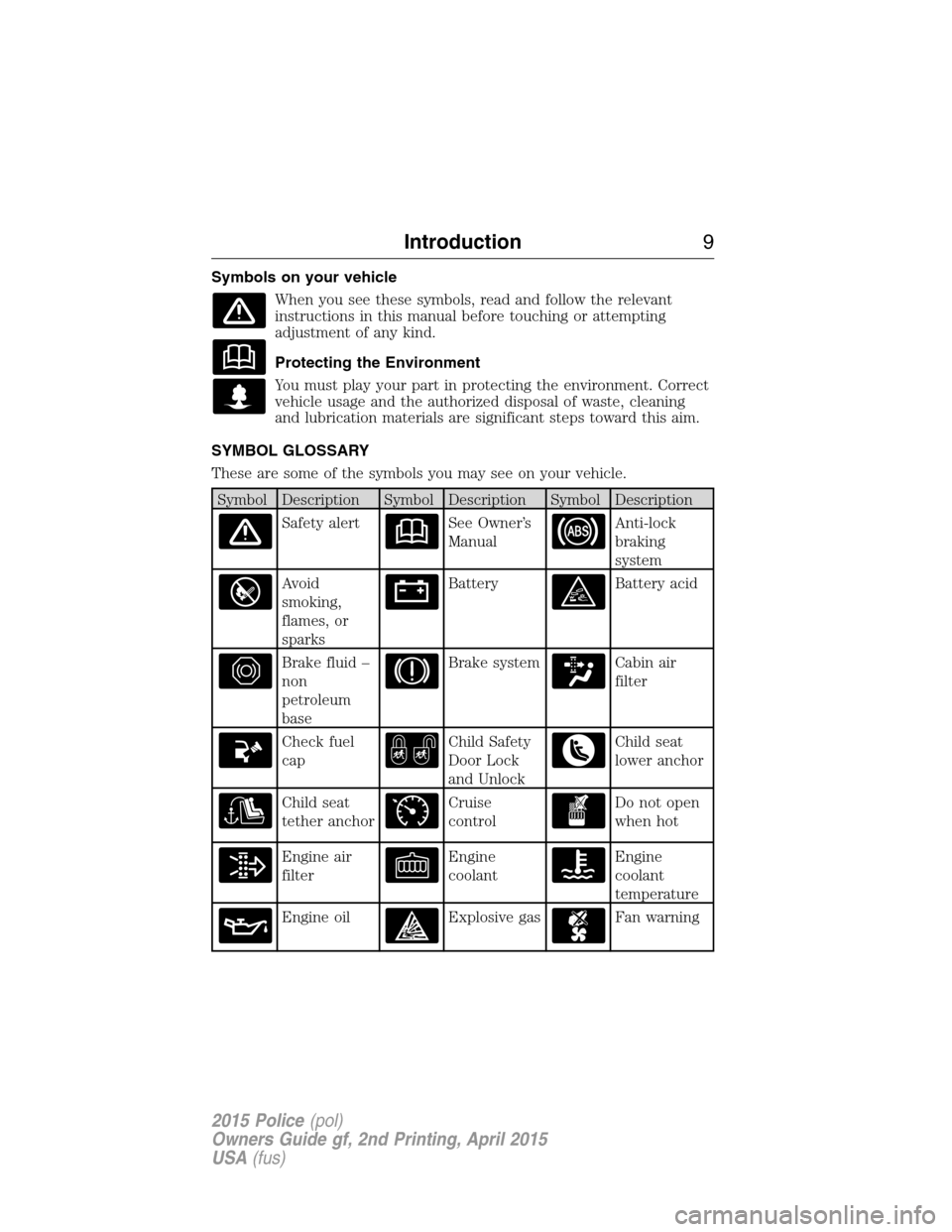
Symbols on your vehicle
When you see these symbols, read and follow the relevant
instructions in this manual before touching or attempting
adjustment of any kind.
Protecting the Environment
You must play your part in protecting the environment. Correct
vehicle usage and the authorized disposal of waste, cleaning
and lubrication materials are significant steps toward this aim.
SYMBOL GLOSSARY
These are some of the symbols you may see on your vehicle.
Symbol Description Symbol Description Symbol Description
Safety alertSee Owner’s
ManualAnti-lock
braking
system
Avoid
smoking,
flames, or
sparksBatteryBattery acid
Brake fluid –
non
petroleum
baseBrake systemCabin air
filter
Check fuel
capChild Safety
Door Lock
and UnlockChild seat
lower anchor
Child seat
tether anchorCruise
controlDo not open
when hot
Engine air
filterEngine
coolantEngine
coolant
temperature
Engine oilExplosive gasFan warning
Introduction9
2015 Police(pol)
Owners Guide gf, 2nd Printing, April 2015
USA(fus)
Page 11 of 401
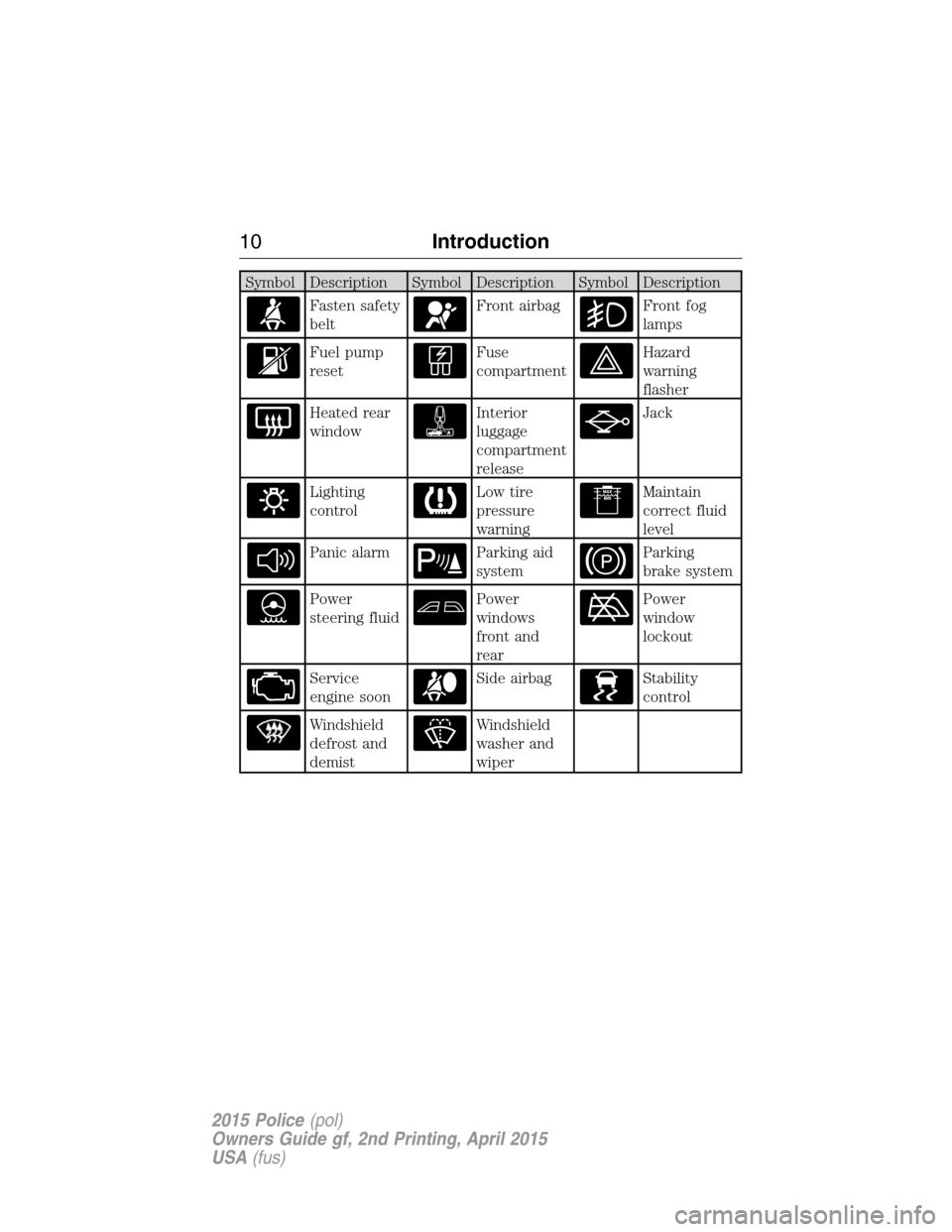
Symbol Description Symbol Description Symbol Description
Fasten safety
beltFront airbagFront fog
lamps
Fuel pump
resetFuse
compartmentHazard
warning
flasher
Heated rear
windowInterior
luggage
compartment
releaseJack
Lighting
controlLow tire
pressure
warningMaintain
correct fluid
level
Panic alarmParking aid
systemParking
brake system
Power
steering fluidPower
windows
front and
rearPower
window
lockout
Service
engine soonSide airbagStability
control
Windshield
defrost and
demistWindshield
washer and
wiper
10Introduction
2015 Police(pol)
Owners Guide gf, 2nd Printing, April 2015
USA(fus)
Page 25 of 401
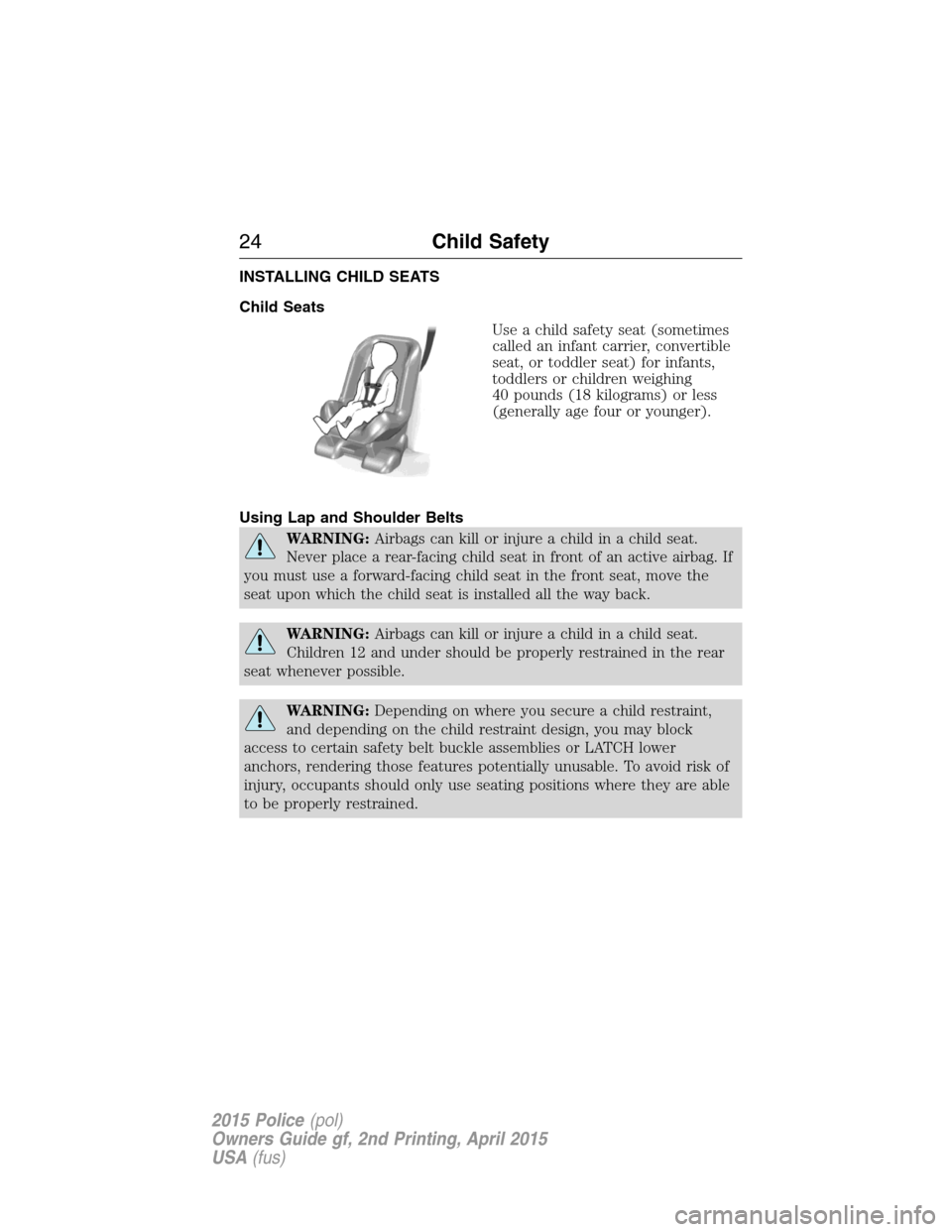
INSTALLING CHILD SEATS
Child Seats
Use a child safety seat (sometimes
called an infant carrier, convertible
seat, or toddler seat) for infants,
toddlers or children weighing
40 pounds (18 kilograms) or less
(generally age four or younger).
Using Lap and Shoulder Belts
WARNING:Airbags can kill or injure a child in a child seat.
Never place a rear-facing child seat in front of an active airbag. If
you must use a forward-facing child seat in the front seat, move the
seat upon which the child seat is installed all the way back.
WARNING:Airbags can kill or injure a child in a child seat.
Children 12 and under should be properly restrained in the rear
seat whenever possible.
WARNING:Depending on where you secure a child restraint,
and depending on the child restraint design, you may block
access to certain safety belt buckle assemblies or LATCH lower
anchors, rendering those features potentially unusable. To avoid risk of
injury, occupants should only use seating positions where they are able
to be properly restrained.
24Child Safety
2015 Police(pol)
Owners Guide gf, 2nd Printing, April 2015
USA(fus)
Page 26 of 401
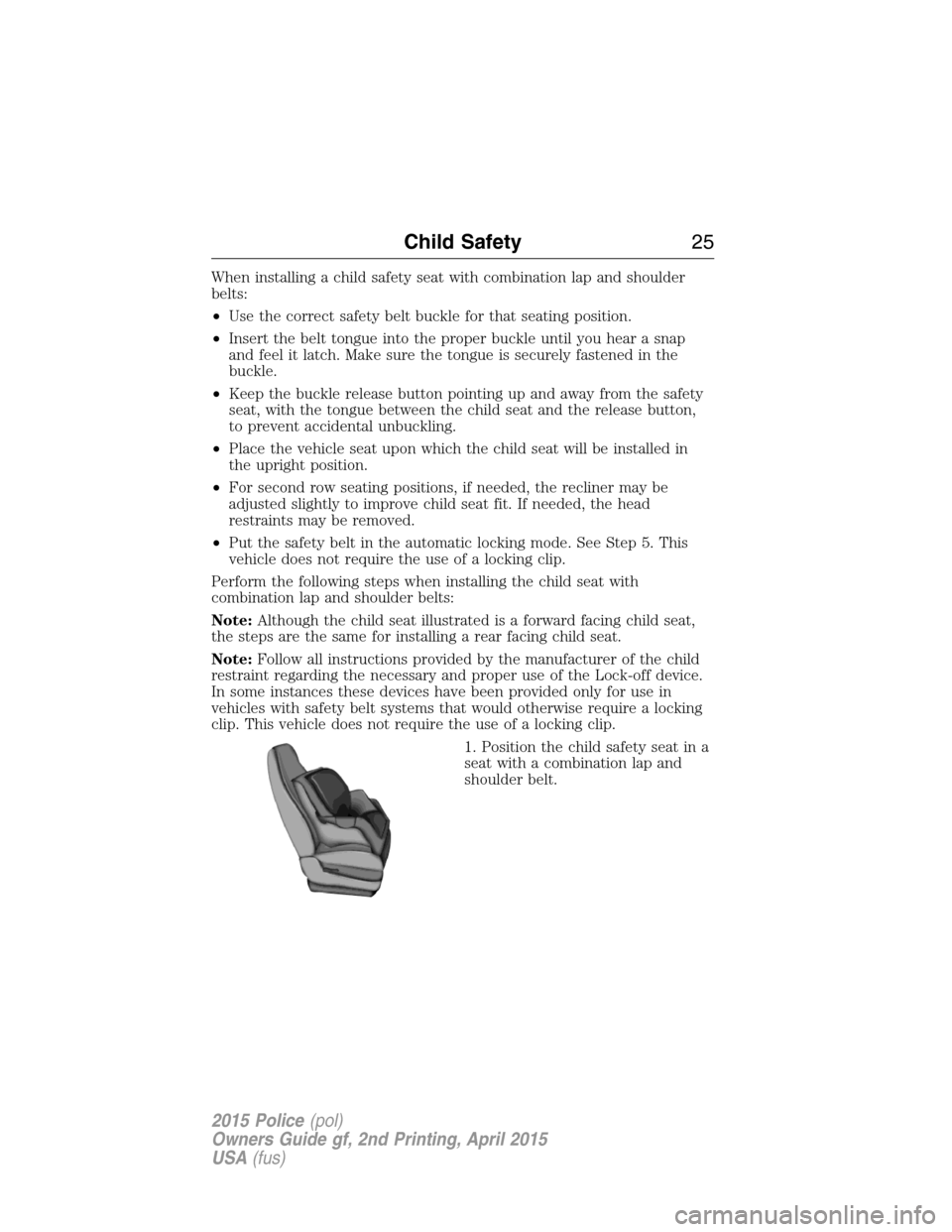
When installing a child safety seat with combination lap and shoulder
belts:
•Use the correct safety belt buckle for that seating position.
•Insert the belt tongue into the proper buckle until you hear a snap
and feel it latch. Make sure the tongue is securely fastened in the
buckle.
•Keep the buckle release button pointing up and away from the safety
seat, with the tongue between the child seat and the release button,
to prevent accidental unbuckling.
•Place the vehicle seat upon which the child seat will be installed in
the upright position.
•For second row seating positions, if needed, the recliner may be
adjusted slightly to improve child seat fit. If needed, the head
restraints may be removed.
•Put the safety belt in the automatic locking mode. See Step 5. This
vehicle does not require the use of a locking clip.
Perform the following steps when installing the child seat with
combination lap and shoulder belts:
Note:Although the child seat illustrated is a forward facing child seat,
the steps are the same for installing a rear facing child seat.
Note:Follow all instructions provided by the manufacturer of the child
restraint regarding the necessary and proper use of the Lock-off device.
In some instances these devices have been provided only for use in
vehicles with safety belt systems that would otherwise require a locking
clip. This vehicle does not require the use of a locking clip.
1. Position the child safety seat in a
seat with a combination lap and
shoulder belt.
Child Safety25
2015 Police(pol)
Owners Guide gf, 2nd Printing, April 2015
USA(fus)
Page 28 of 401
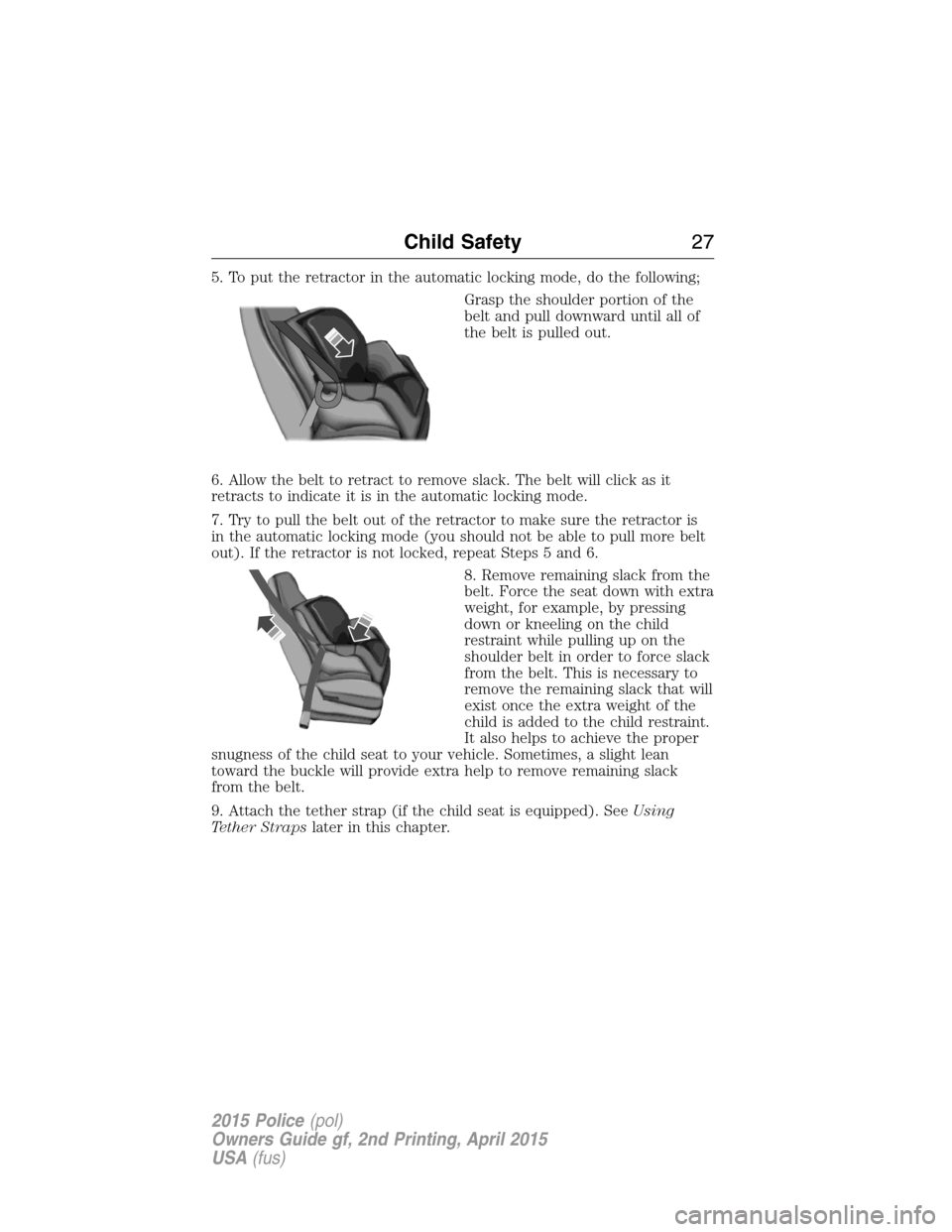
5. To put the retractor in the automatic locking mode, do the following;
Grasp the shoulder portion of the
belt and pull downward until all of
the belt is pulled out.
6. Allow the belt to retract to remove slack. The belt will click as it
retracts to indicate it is in the automatic locking mode.
7. Try to pull the belt out of the retractor to make sure the retractor is
in the automatic locking mode (you should not be able to pull more belt
out). If the retractor is not locked, repeat Steps 5 and 6.
8. Remove remaining slack from the
belt. Force the seat down with extra
weight, for example, by pressing
down or kneeling on the child
restraint while pulling up on the
shoulder belt in order to force slack
from the belt. This is necessary to
remove the remaining slack that will
exist once the extra weight of the
child is added to the child restraint.
It also helps to achieve the proper
snugness of the child seat to your vehicle. Sometimes, a slight lean
toward the buckle will provide extra help to remove remaining slack
from the belt.
9. Attach the tether strap (if the child seat is equipped). SeeUsing
Tether Strapslater in this chapter.
Child Safety27
2015 Police(pol)
Owners Guide gf, 2nd Printing, April 2015
USA(fus)
Page 29 of 401
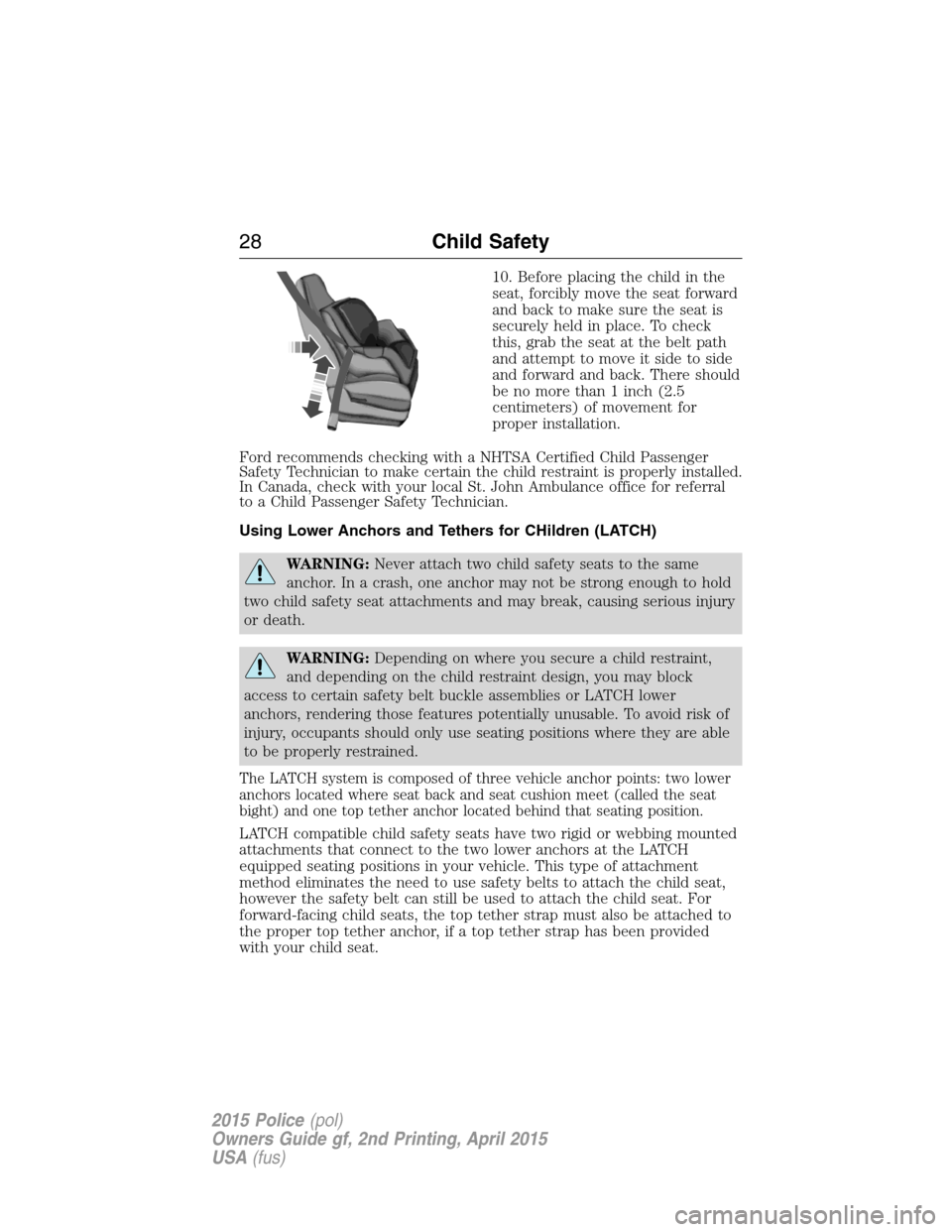
10. Before placing the child in the
seat, forcibly move the seat forward
and back to make sure the seat is
securely held in place. To check
this, grab the seat at the belt path
and attempt to move it side to side
and forward and back. There should
be no more than 1 inch (2.5
centimeters) of movement for
proper installation.
Ford recommends checking with a NHTSA Certified Child Passenger
Safety Technician to make certain the child restraint is properly installed.
In Canada, check with your local St. John Ambulance office for referral
to a Child Passenger Safety Technician.
Using Lower Anchors and Tethers for CHildren (LATCH)
WARNING:Never attach two child safety seats to the same
anchor. In a crash, one anchor may not be strong enough to hold
two child safety seat attachments and may break, causing serious injury
or death.
WARNING:Depending on where you secure a child restraint,
and depending on the child restraint design, you may block
access to certain safety belt buckle assemblies or LATCH lower
anchors, rendering those features potentially unusable. To avoid risk of
injury, occupants should only use seating positions where they are able
to be properly restrained.
The LATCH system is composed of three vehicle anchor points: two lower
anchors located where seat back and seat cushion meet (called the seat
bight) and one top tether anchor located behind that seating position.
LATCH compatible child safety seats have two rigid or webbing mounted
attachments that connect to the two lower anchors at the LATCH
equipped seating positions in your vehicle. This type of attachment
method eliminates the need to use safety belts to attach the child seat,
however the safety belt can still be used to attach the child seat. For
forward-facing child seats, the top tether strap must also be attached to
the proper top tether anchor, if a top tether strap has been provided
with your child seat.
28Child Safety
2015 Police(pol)
Owners Guide gf, 2nd Printing, April 2015
USA(fus)
Page 35 of 401
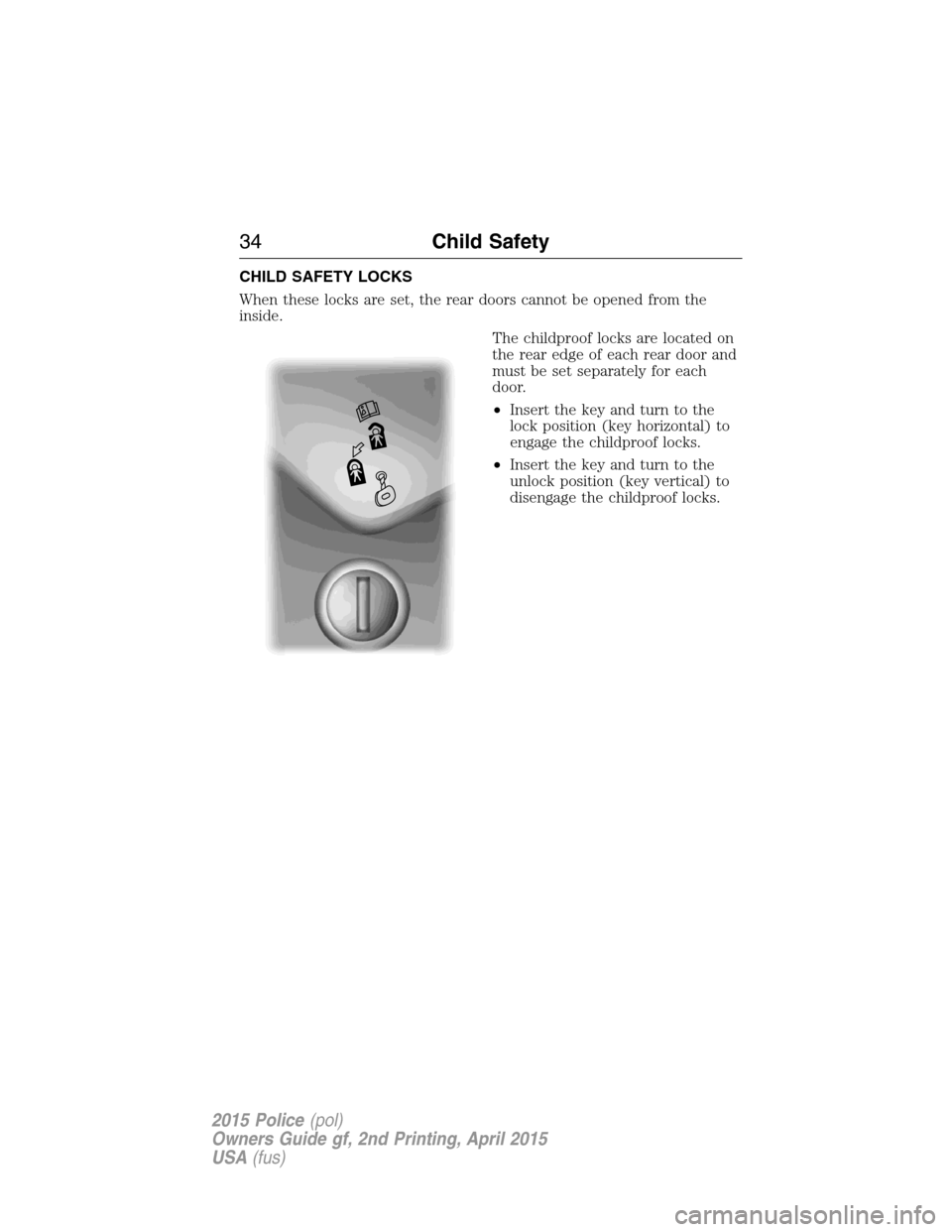
CHILD SAFETY LOCKS
When these locks are set, the rear doors cannot be opened from the
inside.
The childproof locks are located on
the rear edge of each rear door and
must be set separately for each
door.
•Insert the key and turn to the
lock position (key horizontal) to
engage the childproof locks.
•Insert the key and turn to the
unlock position (key vertical) to
disengage the childproof locks.
34Child Safety
2015 Police(pol)
Owners Guide gf, 2nd Printing, April 2015
USA(fus)